The Hong Kong Signal Company and the SS Lisbon Maru
This blog post originally appeared on my website dealing with Royal Signals honours and awards. With the closure of that site I have updated it and moved it here.
It is written in memory of the officers and men of Royal Signals who died during the sinking of the SS Lisbon Maru eighty years ago on 2 October 1942, and of those others who were killed in action during the Battle for Hong Kong or who later died as prisoners of war.
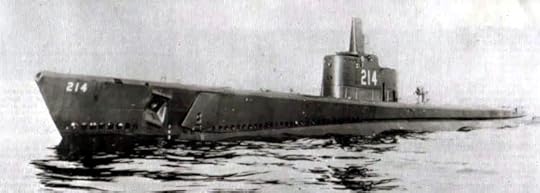
USS Grouper
Before dawn on 1 October 1942 off the small islands at the eastern extremity of the Zhoushan archipelago near Shanghai, Lieutenant Commander Rob Roy McGregor, United States Navy, commanding the submarine USS Grouper, spotted a perfect target—a Japanese freighter of about 7,000 tons. Having delayed his attack until just after daylight, McGregor fired a first salvo of three torpedoes; all missed. A fourth hit the freighter’s stern and she hove to. Sometime later, seeing that she was not sinking, McGregor fired a fifth torpedo and then a sixth, which also missed. Grouper had now been spotted, however, and under attack she made a run for safety.[1]
The freighter was the SS Lisbon Maru, a 22-year-old general cargo ship converted to carry a human cargo. On board were 1,834 prisoners of war from Hong Kong and 780 Japanese soldiers.
Japan had attacked Hong Kong on 8 December 1941 and after 17 days of hard fighting the garrison surrendered on Christmas Day. For the first time, a British colony had been captured and a little under 11,000 men went into captivity on or near the island.
When the battle began, the Hong Kong Signal Company numbered seven officers and 178 other ranks. Its efforts during the battle, which were highly praised, were greatly added to by 33 all ranks from the Royal Canadian Corps of Signals who supported ‘C’ Force, the Canadian contingent. Additionally, support was provided by the signallers of the locally raised Hong Kong Volunteer Defence Force Fortress Signal Company and Hong Kong Volunteer Defence Force Signals. The diary compiled by the Chief Signal Officer, Lieutenant Colonel E. O. Levett, describes in detail the work done by the company during the fighting and it is clear that it contributed materially to the battle. For their services during the defence of Hong Kong Lieutenant Colonel Levett would be awarded the OBE, Lieutenant H. C. Spong earned an MBE, Sergeant C. A. Page and Corporal J. B. Stott were awarded the Military Medal and Signalman C. F. Hodgson was mentioned in despatches. For details on the men of the company and the other signal units, and all the awards earned and citations see the roll below.
Early in 1942, the Japanese reorganised the prisoners, with those of the British Army, including the men of the Hong Kong Signal Company, being imprisoned in Sham Shui Po Barracks in Kowloon. Officers were moved to Argyle Street Camp in April 1942, along with some men to act as cooks and batmen. Needing labour to support the war economy at home, the Japanese planned to move prisoners from Hong Kong to Japan in the summer of 1942. The first transportation of 620 men left on board the SS Shi Maru on 4 September. The second transportation was scheduled for the end of the month.
In late September 1942, 1,834 men were moved to the docks to board the freighter Lisbon Maru; this contingent included three officers and 126 other ranks from the Hong Kong Signal Company. On 26 September, 780 Japanese soldiers, including some wounded men, boarded the ship and she sailed the next day. Conditions on board for the prisoners were grim—the holds were cramped, the air was hot and foul, food was minimal, and diseased men went untreated. Diphtheria broke out after a few days at sea and the few medical supplies available soon ran out. Hugging the coast, the ship sailed north until on 1 October it was in the East China Sea about 20 miles off the Zhoushan archipelago.
[image error]SS Lisbon Maru
On the evening after it had been hit, while under tow to shallower water the ship began to list and a Japanese destroyer and another cargo ship took off most of the Japanese soldiers and crew. The hatches to the holds had been battened down and the prisoners were left to their fate as the Lisbon Maru settled by the stern. The following morning the ship listed further and men began to break out of the hold, only to be confronted by guards willing to shoot them down. The guards were soon overpowered and the men took to the sea. Land could be seen in the distance—the Dongji Islands—and those that could struck out, taking hours to swim the four miles or so to land. Some were picked up by Chinese fishing boats that had set out from the islands several miles away. Later in the day some men were picked up by Japanese boats.
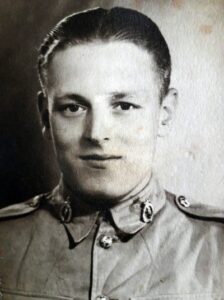
Signalman Arnie Topliff BEM
It was on 2 October that Signalman Arnie Topliff, who had managed to swim to the islands, acted most bravely. The currents along the islands’ weather shores were strong and the waves battered the shoreline with considerable force. Topliff saw that another survivor was unable to reach land and was being taken out to sea by a change in the current. Although exhausted, and at considerable risk, he went back into the water and rescued an officer of the Middlesex Regiment, Captain C. M. M. Man.[2] Signalman Topliff’s award was instigated by Captain Man and announced in March 1946 after his release from captivity.[3] You can read more about Signalman Topliffe here.
Eight hundred and twenty-eight men died when the Lisbon Maru sank, or in trying to swim to safety, or were murdered in the water by the Japanese. One officer and 49 Royal Signals soldiers died, among them were Sergeant Page and Corporal Stott, who would never hear that they had been rewarded for their gallantry during the battle; all are commemorated on the Sai Wan Memorial in Hong Kong.
The survivors from the Lisbon Maru were taken by the Japanese to Shanghai before sailing again for Japan and captivity. Forty-four men, those too sick to be moved and men detailed to look after them, were left behind in Shanghai. Sixteen of these men died, including two Royal Signals soldiers—Corporal J. H. Watts and Signalman W. J. Newbold. Their ashes were buried in Woosung (Wusong) Cemetery; they were reinterred in Yokohama War Cemetery in 1946.
Seventy-seven Royal Signals survivors from the Lisbon Maru finally arrived in Japan and went to work in Osaka as stevedores in the port; most remained there, although some were moved to other camps in the region. A further 23 Royal Signals other ranks from the company were brought to Japan on other transports. Sadly 17 men did not see the end of the war; their ashes are interred in Yokohama War Cemetery. Two others died in an air crash after their release in 1945.
The Hong Kong Signal Company had suffered grievously—93 men, more than half, were killed in action, died of wounds, or died in captivity.

The Hong Kong Signal Company Roll
The Roll above (opens as a pdf) records all who served with the various signal units in Hong Kong, the fate of the prisoners, and the citations for those rewarded for their conduct; it has been substantially revised since it’s original publication.


Bibliography
Somewhat surprisingly, given his comprehensive coverage of almost every other aspect of the history of Royal Signals during the Second World War, Major General R. F. H. Nalder confines his comments about the Battle for Hong Kong to a very short paragraph that does not even mention the Hong Kong Signal Company. Those that wish to read more about the battle, Royal Signals’ contribution to it and the fate of the prisoners, must look elsewhere.
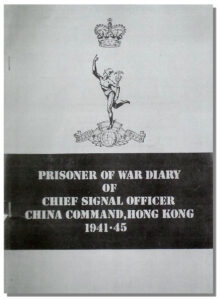 The Chief Signal Officer, Lieutenant Colonel E. O. Levett OBE, compiled a detailed war diary and a captivity diary, which are now held by the Royal Signals Museum (a copy may be found in the Imperial War Museum). The latter records the officers of all services held as prisoners and the fate of the men of the signal company. The original documents are now held by the Royal Signals Museum but they were transcribed after Levett’s death by Lieutenant Colonel Monty Truscott, a corporal at the time of the battle.[4] I have to thank Vic Ient, the son of Sergeant A. V. Ient, for sending me a copy of the diary; the story of Sergeant Albert Ient, who survived the Lisbon Maru sinking, may be found on the Ient family website.
The Chief Signal Officer, Lieutenant Colonel E. O. Levett OBE, compiled a detailed war diary and a captivity diary, which are now held by the Royal Signals Museum (a copy may be found in the Imperial War Museum). The latter records the officers of all services held as prisoners and the fate of the men of the signal company. The original documents are now held by the Royal Signals Museum but they were transcribed after Levett’s death by Lieutenant Colonel Monty Truscott, a corporal at the time of the battle.[4] I have to thank Vic Ient, the son of Sergeant A. V. Ient, for sending me a copy of the diary; the story of Sergeant Albert Ient, who survived the Lisbon Maru sinking, may be found on the Ient family website.
Something of the story of the Hong Kong Signal Company—captivity in Hong Kong, the sinking of the Lisbon Maru and subsequent events—were described by ‘Monty’ Truscott. His wartime experiences were captured by the Imperial War Museum’s oral history project and may be heard here. Another of the company’s survivors taken to Japan on a later transport was Sergeant Vic Ient—his story may be read here. Signalman Maynard Skinner also survived the sinking of the Lisbon Maru and Vic Ient’s son interviewed him—his story is here. He also interviewed Signalman Bill Butler—his story is here. The experiences of a fellow prisoner and later a friend of Arnie Topliff, George Bainborough, were recorded by the Imperial War Museum and may be found here.
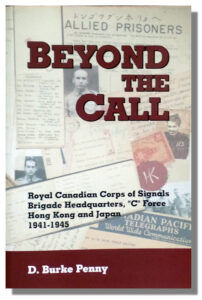 A second source that is worthy of greater exposure is the story of the Royal Canadian Corps of Signals detachment, part of ‘C’ Force, which arrived on Hong Kong just before the Japanese invasion. Beyond the Call was written by D. Burke Penny, the nephew of one of the Canadian signallers, Corporal Donald A. Penny. Penny has an excellent blog which provides a huge amount of additional information about the role of Signals in the battle and about the men who took part. The book is available through the Hong Kong Veterans Commemorative Association of Canada and is highly recommended. Biographies of the men of ‘C’ Force Signals may also be found on the HKVCA website (see here).
A second source that is worthy of greater exposure is the story of the Royal Canadian Corps of Signals detachment, part of ‘C’ Force, which arrived on Hong Kong just before the Japanese invasion. Beyond the Call was written by D. Burke Penny, the nephew of one of the Canadian signallers, Corporal Donald A. Penny. Penny has an excellent blog which provides a huge amount of additional information about the role of Signals in the battle and about the men who took part. The book is available through the Hong Kong Veterans Commemorative Association of Canada and is highly recommended. Biographies of the men of ‘C’ Force Signals may also be found on the HKVCA website (see here).
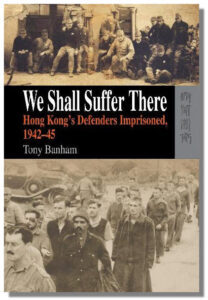 The most important source of information about the battle and the fate of the prisoners is the series of three books by Tony Banham. His website Hong Kong War Diary has details of these and a huge amount of additional information. A large amount of information has been amassed on the website of Gwulo: Old Hong Hong, including the original POW records compiled by Tse Dickuan BEM, part of the Elizabeth Ride Collection.
The most important source of information about the battle and the fate of the prisoners is the series of three books by Tony Banham. His website Hong Kong War Diary has details of these and a huge amount of additional information. A large amount of information has been amassed on the website of Gwulo: Old Hong Hong, including the original POW records compiled by Tse Dickuan BEM, part of the Elizabeth Ride Collection.
For information about prisoners of war in Japan and the camps in which they were incarcerated see: Center For Research Allied POWS Under The Japanese.
Details of the prisoners taken to Japan may be found at the POW Research Network Japan.
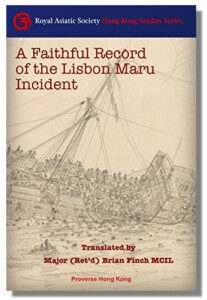 Highly recommended is the story from the point of view of the Chinese fishermen who rescued survivors and who hid several prisoners who finally escaped. A Faithful Record of the Lisbon Maru Incident is a translation of the original Chinese publication by Major Brian Finch, an officer of the Middlesex Regiment who has done much to contribute to the memorialisation of the sinking of the Lisbon Maru.
Highly recommended is the story from the point of view of the Chinese fishermen who rescued survivors and who hid several prisoners who finally escaped. A Faithful Record of the Lisbon Maru Incident is a translation of the original Chinese publication by Major Brian Finch, an officer of the Middlesex Regiment who has done much to contribute to the memorialisation of the sinking of the Lisbon Maru.
Finally, various articles have appeared in The Wire over the years:
The Torpedoing of the Lisbon Maru. March/April 1967, p. 118. (An account of the sinking of the Lisbon Maru by 2325210 Signalman W. T. E. Bevan.)
Lest we Forget Hong Kong- December 1941. July/August 1969, p. 260. (An account of the battle using extracts from Levett’s diary.)
Survivors of Hong Kong Signal Company (1939-49) meet for their first Reunion. July/August 1969, p. 260.
Hong Kong Signal Company 1939-45. July/August 1970 p. 289.
Third Reunion of the Hong Kong Signal Company (1939-45). August/September 1971, p. 294.
The 4th Annual Re-union of the Hong Kong Signal Company 1939-45. October/November 1972, p. 409.
Filth Reunion of the Hong Kong Signal Company 1939·45. October/November 1973, p. 448.
Sixth Reunion, Hong Kong Signal Company 1939-45. November/December 1974, p. 483.
Seventh Reunion of the Hong Kong Signal Company 1939-45. November/December 1975, p. 374.
8th Reunion of the Hong Kong Signal Company 1939-45. November 1976, p. 378.
Ninth Reunion of the Hong Kong Signal Company 1939-45. November 1977, p. 486.
Tenth Reunion of the Hong Kong Signal Company 1939-45. November 1978, p. 357.
Hong Kong Signal Company 1939-45—11th Reunion. November 1979, p. 473.
The Hong Kong Signal Company 1939-45—Twelfth Reunion. November 1980, p. 533. (The final reunion at Blandford.)
Notable Diaries Presented to the Museum. January 1982, p. 11. (The presentation of the diaries compiled by Lieutenant Colonel E. O. Levett OBE.)
1. (Back) USS Grouper (SS-214) was a Gato-class submarine armed with Mark 14 torpedoes. This was Grouper’s second war patrol and McGregor’s first. For this patrol, McGregor was awarded the Silver Star Medal on 13 May 1943:
The President of the United States of America takes pleasure in presenting the Silver Star to Lieutenant Commander Rob Roy McGregor (NSN: 0-62649), United States Navy, for gallantry and intrepidity in the line of his profession as Commanding Officer of the U.S.S. GROUPER (SS-214). He conducted a successful offensive patrol in enemy controlled waters from 28 August to 20 October 1942, and through his skill, aggressiveness and seamanship, succeeded in sinking two enemy merchantmen totaling 12,000 tons and damaging one enemy merchant vessel of 4,000 tons. Despite counter efforts in the way of depth charging by patrolling enemy surface and aircraft, he maneuvered his vessel in such a manner that he brought it through without damage and his crew home without injury. His courage and skill were in keeping with the highest traditions of the United States Naval Service.
Two more Silver Stars followed in March 1945, the first for another war patrol in USS Grouper, and the second for his command of USS Sea Cat (SS-399). McGregor retired as a Rear Admiral in 1957. He died on 5 September 2000, aged 93.
2. (Back) Captain Christopher Mark Morrice Man, The Middlesex Regiment (Duke of Cambridge’s Own). Man survived captivity and in 1946 was awarded the Military Cross for his gallantry during the defence of Hong Kong. Later Major General C. M. M. Man CB, OBE, MC. He attended the eleventh reunion of the Hong Kong Signal Company, held at Blandford in 1979, where he recounted the story of his rescue.
3. (Back) London Gazette 15 March 1946; 37500, p. 1372. Recommendation: The National Archives: WO 373/69/830.
Signalman Topliff was a prisoner of war aboard the Japanese Army transport ‘Lisbon Maru’ when the ship was torpedoed by a United States submarine on 1st October, 1942. He was one of a small number of survivors who escaped by swimming to an island about eight miles distant, despite the ruthless efforts of the Japanese to destroy them by machine gun fire and other means. Another survivor was Captain C. M. M. Man of the Middlesex Regiment, and this officer had almost reached the same island when a change of current began to carry him out to sea. Seeing that Captain Man was in imminent danger, Signalman Topliff, himself in an almost exhausted condition, immediately re-entered the water, swam to the officer and brought him safely to land.
4. (Back) 6746367 Corporal Montague Edward Ephraim Truscott. He remained in Royal Signals after the war, becoming the regimental sergeant major of 63rd Headquarters Line of Communication Signal Regiment (Territorial Army). Commissioned in December 1954, Lieutenant Colonel (Quartermaster) M. E. E. Truscott retired in April 1971. He died in May 1997 , aged 80. For many years he was driving force behind the annual reunions of the Hong Kong Signal Company.
The post The Hong Kong Signal Company and the SS Lisbon Maru first appeared on Nick Metcalfe.


